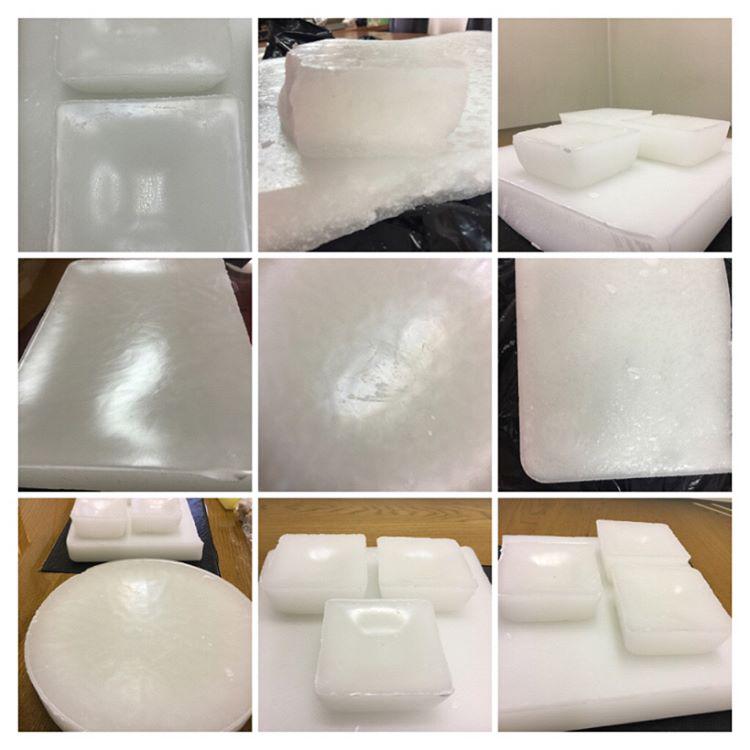
paraffin wax definition

Paraffin wax definition
Paraffin wax chemical compound
Paraffin wax, colorless or white, somewhat translucent, hard wax consisting of a mixture of solid straight-chain hydrocarbons ranging in melting point from about 48° to 66° C (120° to 150° F). Paraffin wax is obtained from petroleum by dewaxing light lubricating oil stocks. It is used in candles, wax paper, polishes, cosmetics, and electrical insulators. It assists in extracting perfumes from flowers, forms a base for medical ointments, and supplies a waterproof coating for wood. In wood and paper matches, it helps to ignite the matchstick by supplying an easily vaporized hydrocarbon fuel.
Paraffin wax was first produced commercially in 1867, less than 10 years after the first petroleum well was drilled. Paraffin wax precipitates readily from petroleum on chilling. Technical progress has served only to make the separations and filtration more efficient and economical. Purification methods consist of chemical treatment, decolorization by adsorbents, and fractionation of the separated waxes into grades by distillation, recrystallization, or both. Crude oils differ widely in wax content.
Synthetic paraffin wax was introduced commercially after World War II as one of the products obtained in the Fischer–Tropsch reaction, which converts coal gas to hydrocarbons. Snow-white and harder than petroleum paraffin wax, the synthetic product has a unique character and high purity that make it a suitable replacement for certain vegetable waxes and as a modifier for petroleum waxes and for some plastics, such as polyethylene. Synthetic paraffin waxes may be oxidized to yield pale yellow, hard waxes of high molecular weight that can be saponified with aqueous solutions of organic or inorganic alkalies, such as borax, sodium hydroxide, triethanolamine, and morpholine. These wax dispersions serve as heavy-duty floor wax, as waterproofing for textiles and paper, as tanning agents for leather, as metal-drawing lubricants, as rust preventives, and for masonry and concrete treatment.
Types of Paraffin Wax
Low Melt Point Paraffin – paraffin with a melting point less than 130° F, this type of wax is soft and adheres well to the sides of containers. Therefore, they are best for container and tealight candles.
High Melt Point Paraffin – paraffin with a melting point greater than 130° F, this type of wax is harder and therefore provides structural rigidity for use in votive and pillar candles.
What Kind of Candles Does it Make?
Pretty much any type of candle can be made with paraffin wax. The melting point is the primary determinant of the
• Is used for container candles in jars, cups or glasses
• Medium melt point paraffin (130°F – 150°F) is used for candles that need to stand on their own – pillars and other molded candles
• High melt point wax (greater than 150°F) is used for more special applications
How It’s Generally Packaged or Sold:
While many of us have seen paraffin wax for canning in small boxes in the grocery store (not the best kind for candles), paraffin candle wax is usually sold in 11 lb. Slabs. (Why they settled on 11 lbs. I don’t know.) There are also a couple of companies that sell paraffin wax in pellet form. This makes weighing it out and melting it super easy!
Candle Wax Facts from the National Candle Association:
• All waxes are primarily hydrocarbons, whether of animal, vegetable, or petroleum origin. The chemical composition of all candle making waxes is similar, and all candle waxes burn in the same manner.
• No specific type of wax or wax blend is considered “best” for candle making. All waxes – when provided in high-quality format – have been shown to burn cleanly, safely and in the same manner.
• No candle wax has ever been shown to be toxic or harmful to human health.
• There is no such thing as a soot-free wax.
• Paraffin waxes have a distinctive crystalline structure, are pale yellow to white (or colorless) and have a melting point range between 122 and 140°F (50 and 60°C).
• Microcrystalline waxes have a poorly defined crystalline structure, darker color, higher viscosity, and higher melting points — ranging from 140 and 199°F (63 and 93°C)
What the dictionary says:
Paraffin: (derived from Latin parum affinis, [little affinity])
A white waxy substance, resembling spermaceti, tasteless and odorless, and obtained from coal tar, wood tar, petroleum, etc., by distillation. It is used in candles, as a sealing agent (such as in canning of preserves), as a waterproofing agent, as an illuminant, and as a lubricant. It is very inert, not being acted upon by most of the strong chemical reagents. It was formerly regarded as a definite compound but is now known to be a complex mixture of several higher hydrocarbons of the methane or marsh-gas series
When you buy paraffin wax to make candles, most of the time it is sold by weight and conditioned as wax pellets. Such a conditioning is ideal as it makes it easy for you to store, manipulate and proportion.
Straight paraffin usually comes with a melting point (MP) of 140°F, which limits its use for “hard” candles like pillars.
It comes free of any additive so the odds are great you’ll need to add one or several additives, depending upon the type of candle you’re planning to make.
But let’s start with the beginning: straight paraffin wax is great for the beginner candle maker and will allow you to familiarize yourself with the different additives, their effect when used in different quantities and also with the ideal pouring temperature in such or such case.
Paraffin waxes
The vast majority of candles produced nowadays are made, totally or partially, of paraffin.
The website of Exxon, one of the largest petrochemical companies, states the following about petroleum-derived waxes:
There are three basic categories of petroleum-derived wax: paraffin (crystalline), microcrystalline and petrolatum.
Feel free to check out the complete technical characteristics of these categories. For the sake of this article, I’ll highlight two important facts:
• Paraffin waxes have a distinctive crystalline structure, are pale yellow to white (or colorless) and have a melting point range between 122 and 140°F (50 and 60°C).
• Microcrystalline waxes have a poorly defined crystalline structure, darker color, higher viscosity, and higher melting points ranging from 140 and 199°F (63 and 93°C)
Paraffin Wax for Arthritis – Topic Overview
You should talk with your doctor before trying paraffin at home. And it’s a good idea to have a physical therapist show you how to do it before you try it yourself.
Procedures
• Melt the wax (use low heat if you use a double boiler). Stir often to speed up the melting.
• Stir in the mineral oil.
• Turn off the heat, and allow the wax to cool until it has a thin film on the top. This will mean it is getting cool enough to put your hand or foot in.
• Use the thermometer to check the temperature of the wax. It should read about 125°F (51.7°C) when you begin your treatment.
• Before you begin, use warm, soapy water to wash the hand or foot you are going to treat. This will keep the paraffin clean so you can use it again for future treatments. Dry your hand or foot completely.
• Relax your hand or foot, and dip it into the paraffin, being very careful not to touch the sides or bottom of the pot. Allow the wax to come to just above the wrist or ankle. If you are unsteady, it helps to have another person guide your hand or foot in and out of the paraffin.
• Lift your hand or foot out, but hold it over the paraffin. Allow it to dry a few seconds until it stops dripping.
• Repeat this process 10 to 12 times. Each time you dip in, stop just below the previous line of wax on your skin. This will keep warm wax from getting in under the wax that is already on your skin and will prevent burning.
• Wrap your hand or foot in plastic wrap or slide it into a plastic bag.
• Next, wrap a towel around your hand or foot and hold it in place with rubber bands or tape.
• Leave the paraffin on for 20 minutes. Then unwrap your hand or foot and slide the paraffin from your hand or foot back into the pot. The wax can be melted and used again.
• Cover the paraffin, and save it for next time.
Is it safe to use paraffin wax as an electrical insulator?
paraffin is a good insulator, but it also is good at burning…. so there is doubt about that
I have a makeshift little battery-powered electrical project and I want to seal up some wires to prevent crossing and just make it a bit more efficient.
We have just seen paraffin in the form of candle wax.
Wax paper type capacitor was widely used at the time before 1965 device. It could stand up to 400V DC with a thin layer of wax as its insulator. Bee wax was also used on IF transformer and receiver RF tuning coil to fix coil spacing. Some old day audio transformer also use bee wax as its isolator.
Just make sure no heat builds up parts like lamp and resistors existed in the circuit where the wax is going to be used.
